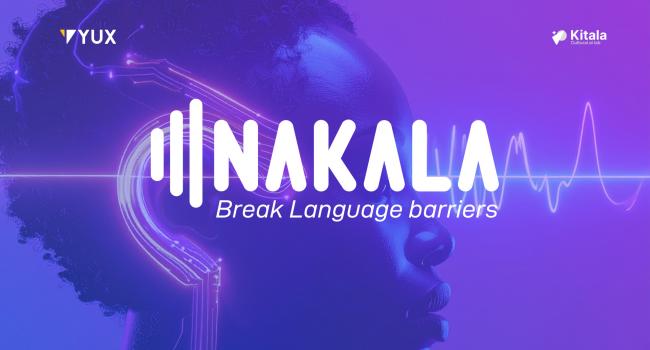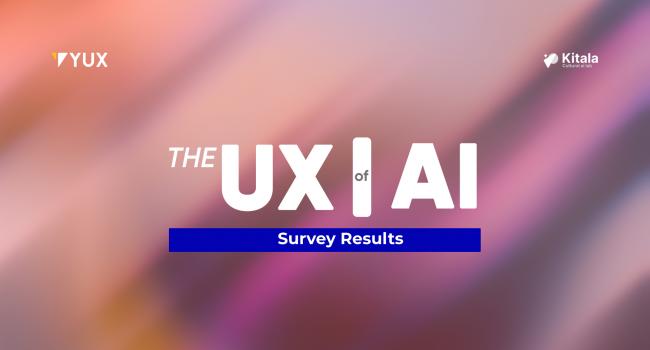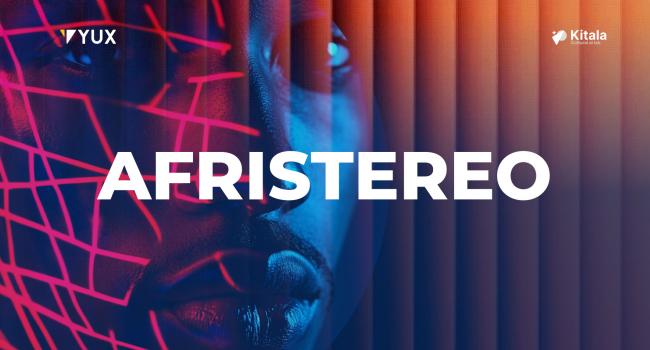During the last few months, with the YUX research team, we have been working on this subject which seems to have a great impact on the Ghanaian market and its population, and we have therefore embarked on a qualitative study in order to understand the flow and the perceptions of the ecological impact of second-hand clothing in Ghana.
The research goal was to understand the perceptions of the different stakeholders within the flow of secondhand clothing within the Ghanaian market and the ecological impact at each stage. We developed tailored questions to understand the thoughts bale retailers, bale selectors, and consumers. This research exposed some of the difficulties consumers find disposing of their secondhand clothes therefore, we developed a solution to suit this problem.
Context
The second-hand clothing industry provides jobs for about 35000 traders and contributes millions of dollars annually to Ghana's GDP within the largest clothing market in Accra called Kantamanto. According to the OR Foundation, approximately 1 million pounds of clothing waste end up at the Kpone landfill sites from the Kantamanto market. These wastes are usually unsold clothes by market traders, which end up in a pile of garbage in the market at the end of each day.
According to Mathilde Charpail of Sustain Your Style, a website that educates users on sustainable fashion choices, fashion is the second-largest polluter in the world. Each stage of the life cycle of clothes has a different negative impact on the environment, as illustrated below.

However, the scope for this project delves into behaviours and thoughts of sellers and consumers, concentrating on the ecological impact of second-hand clothes' as they approach an end of life. i.e. landfill sites, burning, etc.
Scope Description
- Planning Phase: The research process was divided into four phases, as illustrated with timelines below
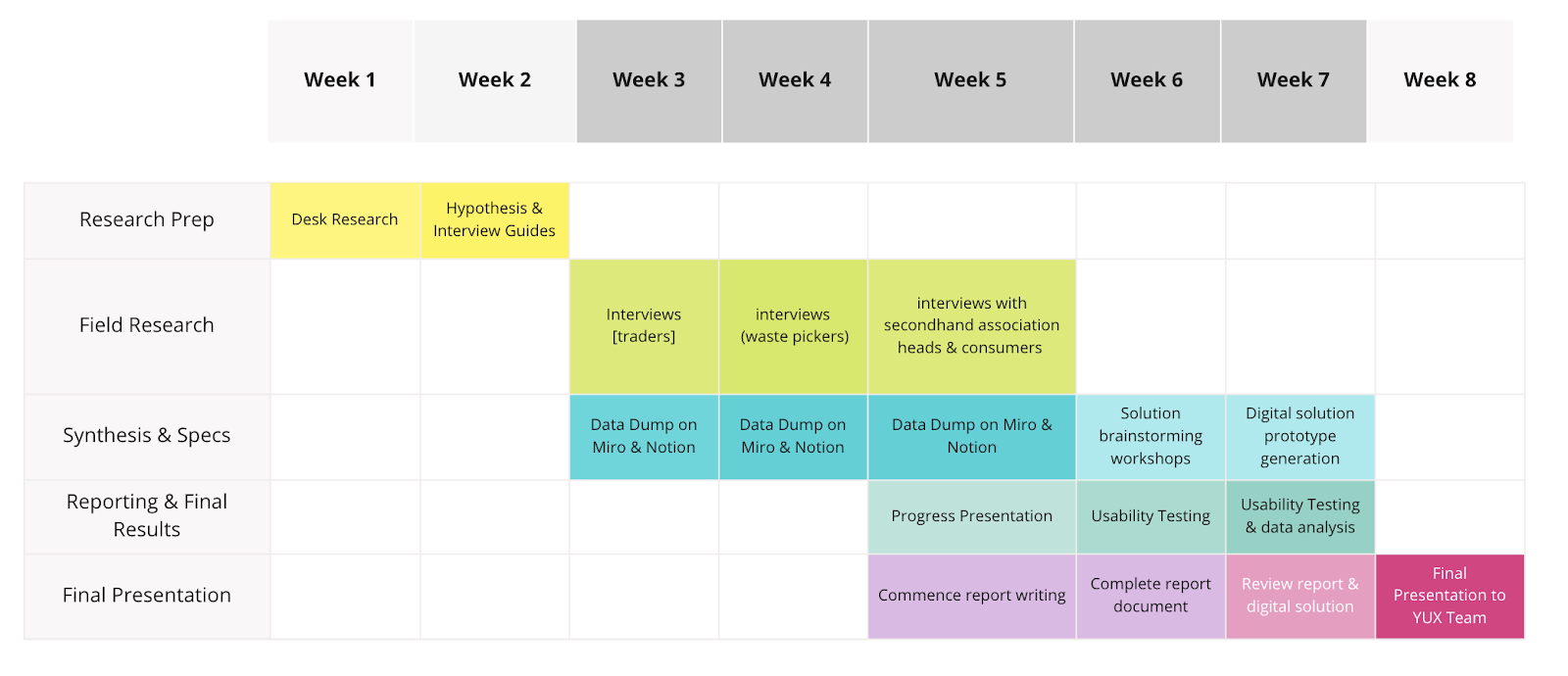
Constraints & Resolutions
- However, considering the realities of living in a pandemic, we had to readjust our ambitious interview list to ensure optimal safety for researchers in the field.
- Availability of market traders: It was difficult to catch market women at a time they are less busy. Therefore, the strategy was to go there on a non-market day (Saturday & Wednesday) within midday to catch them whilst they are on a lunch break.
- Unfavourable working hours of waste pickers & market cleaners: The market waste pickers & market cleaners usually report to work in the wee hours of 5 am in the morning and return in the evening by 7 pm. Therefore, it was very difficult to get an interview with them in the market. Also, due to the Covid, it was not advisable to visit them on the landfill sites (Kpone), therefore, this category of stakeholders was not completed.
- Unwillingness of participants to engage in an interview: Getting participants, especially the market traders to engage in a 30-45mins interview was challenging. Therefore, to incentivize them, a compensation of $50 dollars was given to three market traders after the interview.
Also to encourage some selectors to feel comfortable speaking to me, I would purchase some of their clothing items then engage them in the interview. This strategy was very effective as they were more willing to speak to me since I was now their “customer”.
A total of 11 participants were interviewed for the research. This total number was achieved due to the resolutions adopted above.
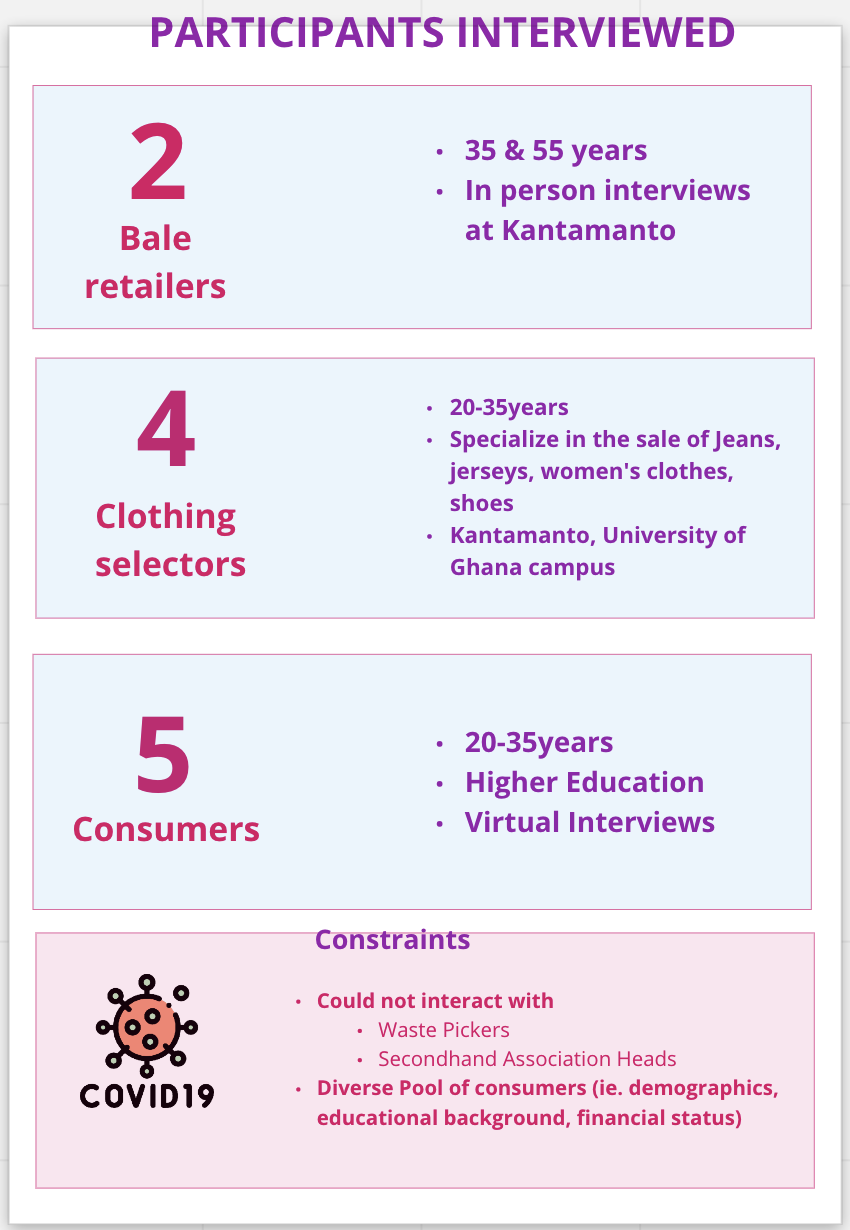
Research Synthesis & Specification
After each week of research with one category of participants, key insights retrieved were documented into Miro while detailed transcripts; data dump, recorded into Notion.
Data collected as thereby synthesized and analysed using exploratory tools such as:
- Ecosystems
- Journey Maps
- Proto Personas
- Key Insights
Ecosystems
An ecosystem helps to analyze the varied interdependent relationships between an interview’s different components with each participant. An ecosystem consists of
- A quote: This is a crucial insight derived from the interview highlighting the interviewee’s standpoint towards the research question.
- Eco-system: This helped to streamline information gathered to highlight vital and essential aspects relevant to the project.
Example of the ecosystem below:
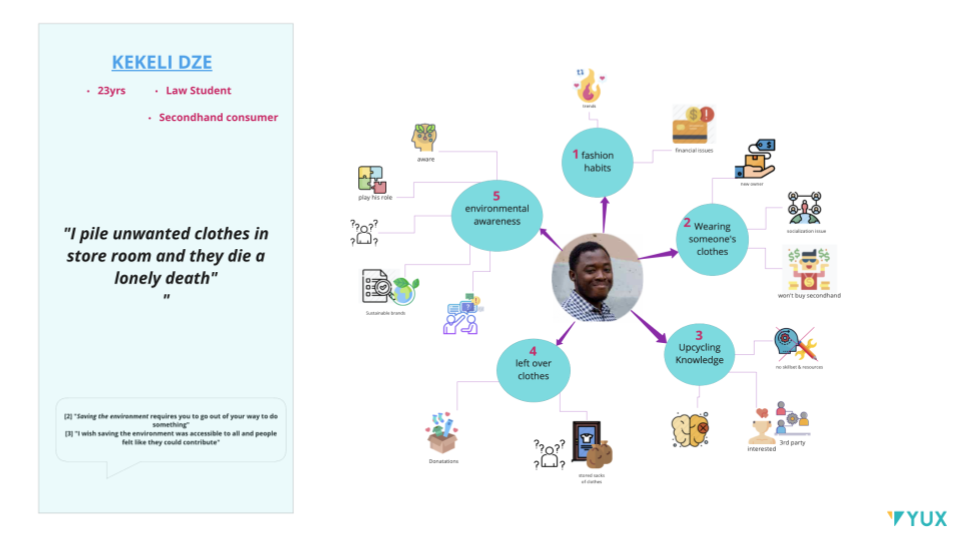
Journey Maps
The flow of clothes through the Ghanaian markets from importation to final consumers involves different stakeholders and intermediaries. Therefore, to fully grasp various stakeholders’ behaviour, a journey map was generated to map out the journey of clothes from importation to landfill sites. (it would be important to refer to glossary for explanation of unfamiliar words)
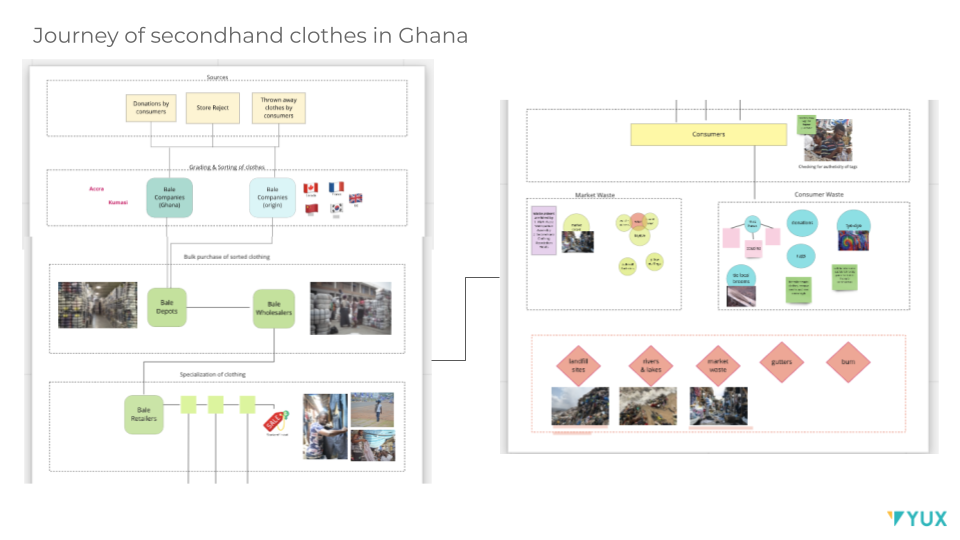
Key Insights
There were several insights and learnings during this course of this research, however, I would highlight 5 key insights under the category of awareness, willingness to act, upcycling knowledge, metric for purchase, and thoughts on wearing someone’s clothes.
1. Awareness: This category highlights the knowledge the various stakeholders have on the ecological impact of clothing, key learnings, and insights.
- Young & educated consumers aware & concerned: The young & educated consumers are aware but mostly do not know how to contribute to the change.
- Lack of information on topics in traditional media. eg. tv, radio, etc.
- Belief that clothes can decompose.ie. termites eat away the fabric.
2. Willingness to act
- Consumers [young & old] are willing to play their role in environmental change.
- Consumers want inclusive solutions that are accessible to all regardless of financial or social status.
- Young consumers want information on which type of materials are recyclable and which brands are sustainable.
- Young consumers do not want solutions that require excessive spending of time and money.
- Market traders are apathetic to the environmental impact of clothes.
3. Upcycling knowledge
- Old consumers appreciated the trend of upcycling (mixing thrift clothing with African print) in the mid-90s for economical reasons.
- Old & young consumers upcycle tailor-made clothing styles when the style is out of trend.
- Young consumers tye-dye old clothes with some making business out of it.
- Young consumers are interested in upcycling but lack skills and resources.
- Young consumers would want the option of a 3rd party revamping old clothes due to time constraints.
4. Metric for purchase
- Young consumers follow fashion trends from social media & TV celebrities.
- Young consumers want vibrant colors and unique styles of clothes.
- Consumers [old & young] look for brand names like Fashion Nova, Topshop, Primark, Burberry when purchasing clothes.
- Consumers complain about the authenticity of tags as market traders have the habit of swapping tags to desirable brands for higher purchases.
- Consumers find clothing size via trial and error.
- Market traders are never sure of the content of bales before purchase: Blind purchase.
- Market traders use information of company history to judge if bale clothes would be of good quality.
- Market traders sometimes purchase bales that visibly have vibrant colors showing through the sackcloth.
5. Thoughts on wearing someone’s clothes
- Consumers are not concerned about wearing second hand because they do not personally know the 1st owner.
- Consumers believe clothes have a new owner once paid for.
- Old consumers sometimes like to purchase second-hand clothes because they can find valuable items in the pockets of the clothes. eg. money, jewellery.
- Young consumers would purchase more tailored and branded clothing when rich than secondhand.
- Consumers believe clothes are disinfected that's why they have a peculiar smell.
Proto Personas
A proto-persona is a description of target users based on assumptions of stakeholders and similarities between individual personas during field research. A proto-persona research analysis was used to help reduce the focus on individual user behaviors but draw similarities that exist to gain opportunities. It is important to note these proto-personas developed in this project might be biased towards a particular participant interview. This is because of the low number of total participants interviewed, therefore, making it difficult to create dense categorization.
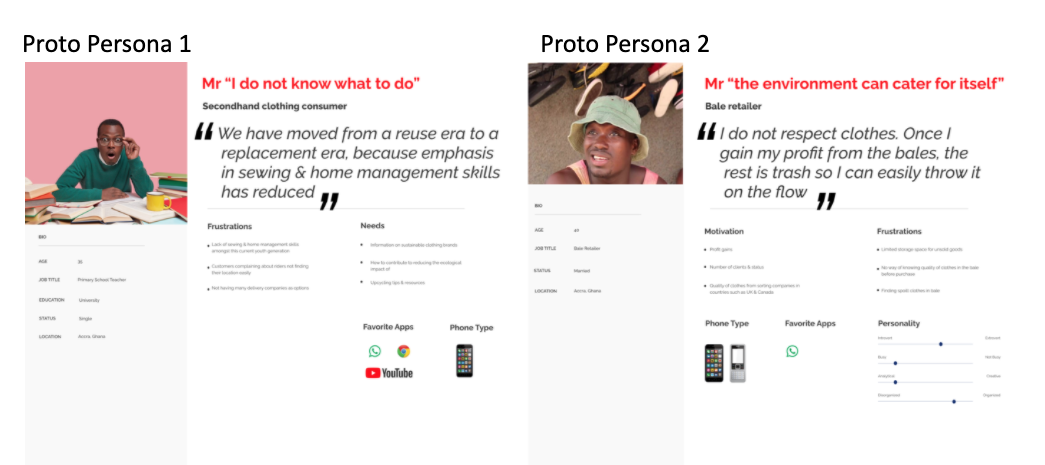
Creative Workshop
A 1.5hrs creative workshop session was held to share creative ideas and brainstorm possible solutions based on analysis and synthesisation of information. Participants of this creative workshop were individuals of different academic, economic, and culturally diverse backgrounds; Nigeria, Senegal, France, Togo,
After an hour of data analysis of the research, three opportunity areas were identified.

After 30-45 mins of brainstorming ideas, there was a total of [x] proposed solutions. These solutions had a combination of digital, [y], [u] solutions. An example of one opportunity area is highlighted below in categories for better understanding.
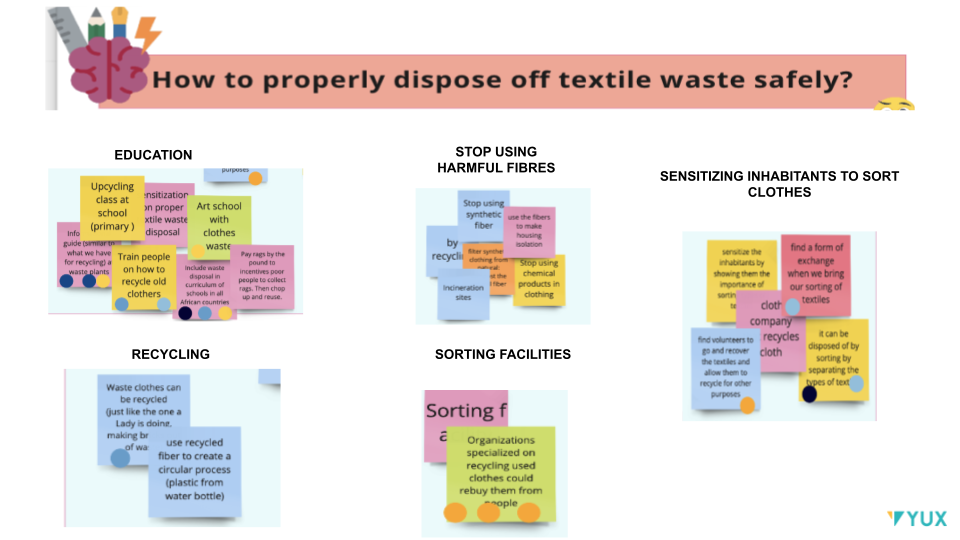
Proposed Solution:
After deliberation, three solutions emerged most popular after extended voting and review on the three opportunity areas presented. Due to the goal of YUX to develop digital solutions, the final solution to the stated problem is highlighted in green.
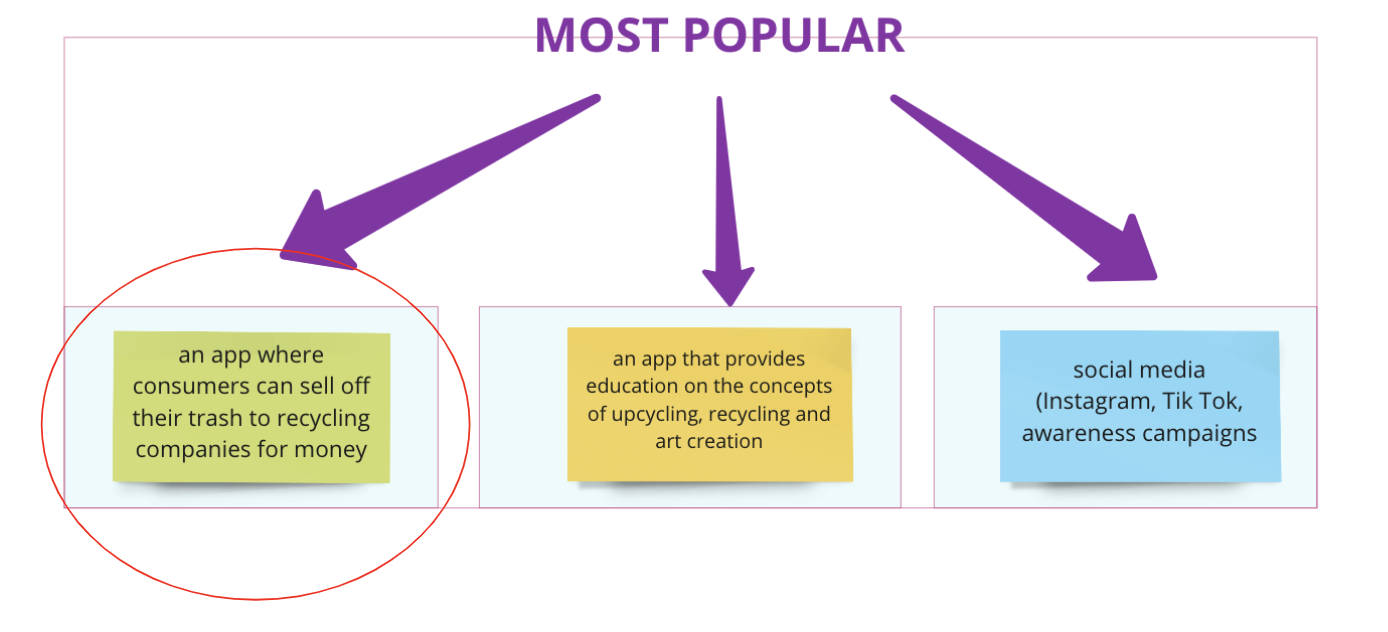
Features of application
An app that uses geolocation to tell consumers the nearest drop off point (charity homes, recycling company or thrift company) for their unwanted clothes. There are two interfaces for the application. ie. consumer side and merchant side.
Functional Requirements
Consumers
- The app should use consumer location, upon request, to give nearest drop off points around him/her ie.charity homes, other thrift shops, recycling companies/collectors
- The app should provide information detailed information on each suggested drop off point
- The app should provide information on the benefits consumers get from sending clothes
- The app should provide a method for drop off or pick up of clothes by a delivery company
- The app should provide information about the types of clothes viable for drop-off at each location and the incentive.
- The app should provide consumers with a form to put in details of the clothes Eg Type of material, [only when sending to the recycling companies] clothing state, colour, type of clothing [when sending to other nearby thrift shops/ charity homes]
- The app should provide consumers with an in-app wallet for transaction of money.
- The app should allow consumers to receive and purchase clothes using their wallet.
How are you paid:
- Paid via Mobile money or any other digital payment options
- You can also gain discounts [20%-40%] to shop in other clothing stores elsewhere. Companies [ thrift shops, recycling companies, charity homes].
- The app should provide companies to sign up & login with ease.
- The app should provide companies with prompts to fill out profile details.
- The app should provide companies with functionality to report on the impact of the
- The app should provide companies with an in-app wallet that would be used for transactions with consumers.
Wireframes
This is the Home screen of the consumer application. On this screen, the consumer is provided with options to view recycling companies, charity homes, or thrift collectors. The information is provided mainly based on consumers location and other filters he/she can adjust later on in the application.
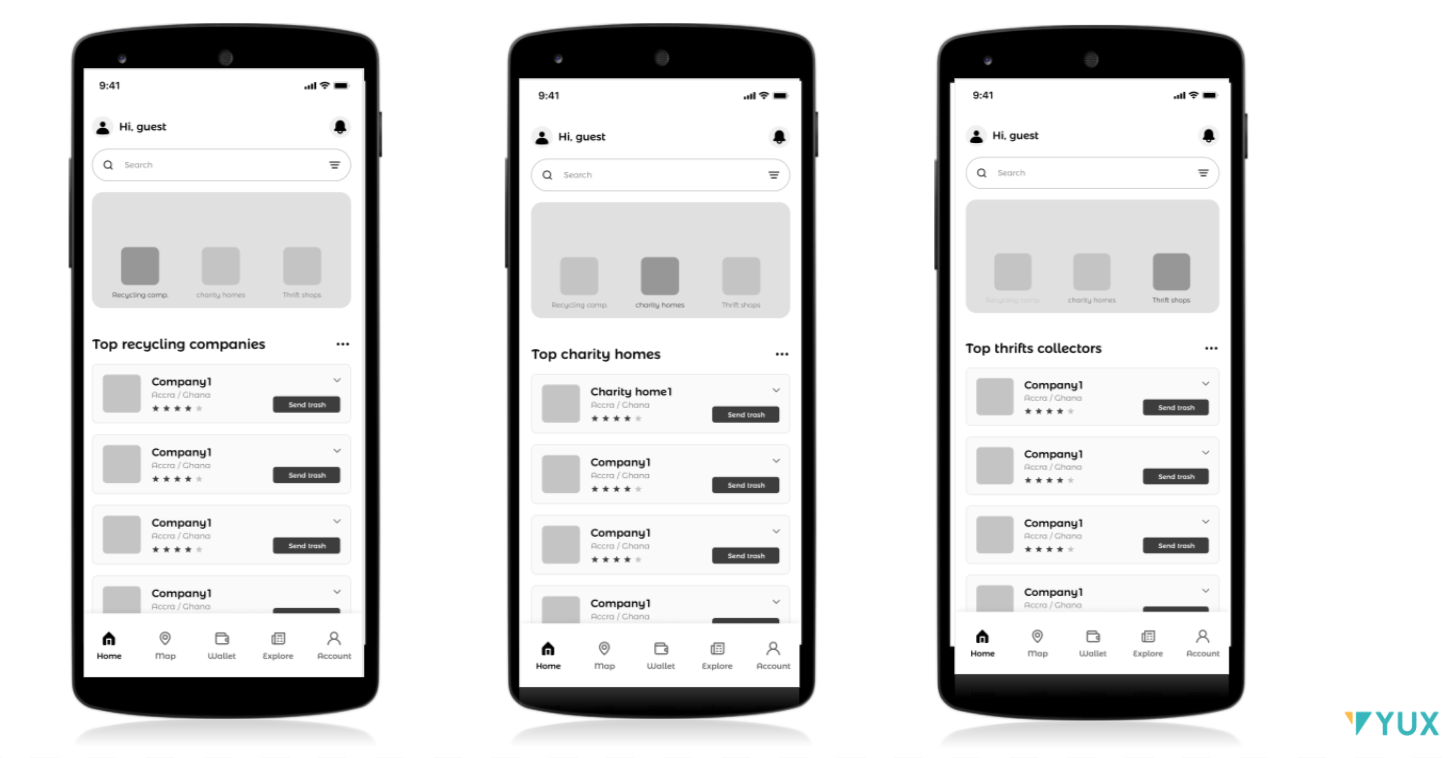
The first two screens are the Map interface. This shows the companies that are close to him/her in a visual form. The consumer can click on one of the companies to get detailed information on their policies, contact details, etc
The last screen is the Explore interface. The consumer can click on this tab to read on latest news in relation to clothes and its impact on the environment, tips for upcycling clothes, learning about new technologies within the recycling & upcycling communities. The consumer can also click on the Help tab to either request for help or respond to help posted by another user in the community. This is to enable the sharing of ideas within the recycling & upcycling space.
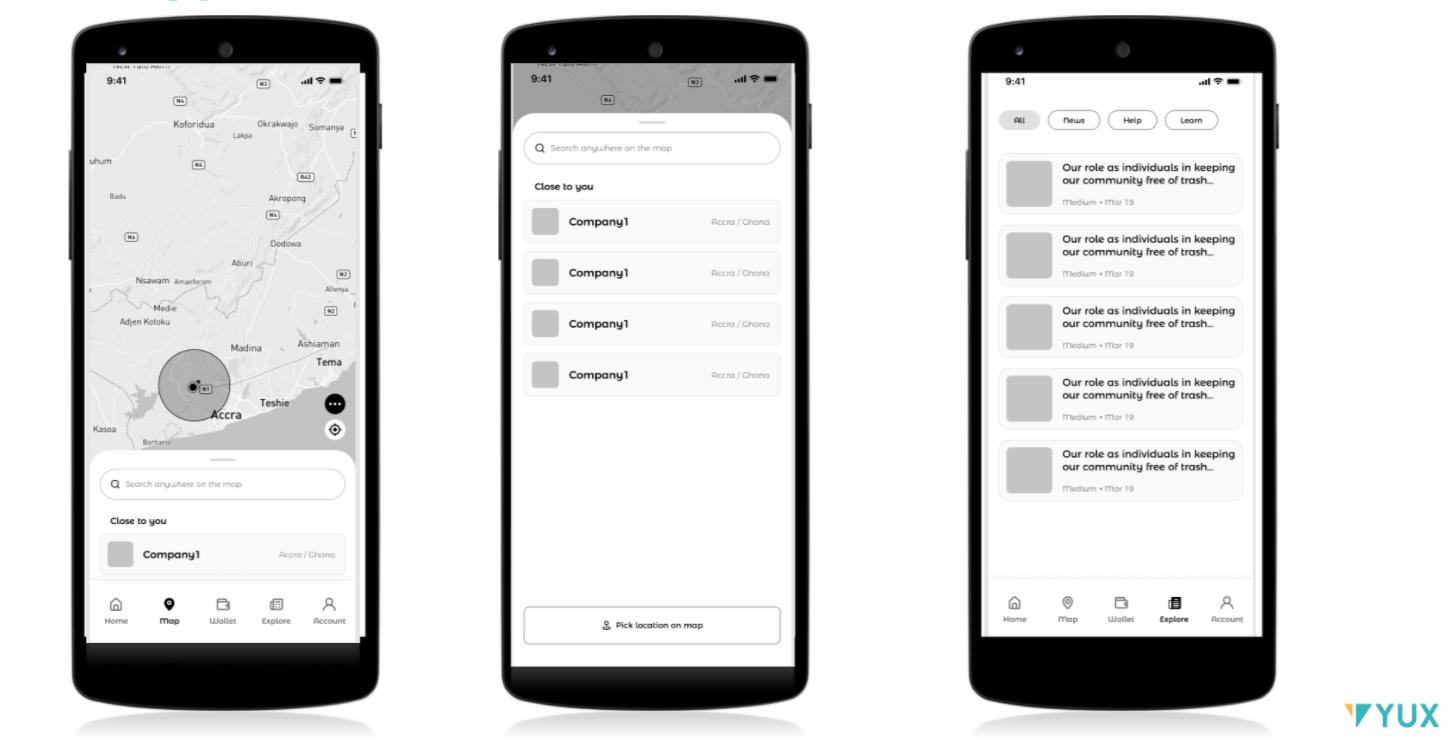
In Summary
This project gave birth to numerous uncertainties in the beginning stages as well as several bottlenecks especially with the field research given the peculiar climate of the COVID 19 pandemic. However, amidst the challenges, the project has seen light with support from my supervisor Camille Courbariaux and the chief researcher Sasha Oseadieyo Ofori.
The research method used was able to handle the rigor of the project with agile components to encourage iterative work. It is also important to highlight the doubts I had with achieving the final results, However, I have come to understand to trust the process and keep the users in mind.
Photo credit: OR Foundation, a USA-based non-profit co-founded by - Liz Ricketts and Branson Skinner.

